|
|
If you are reading these rules for the first time, ignore the text along the right hand side. These rules serve as a summary to help you quickly familiarize yourself with the game.
Show
→ summary only
→ detailed version only
→ both summary and detailed version

Bruges
Bruges in the 15th century - culture and commerce flourish and make the Belgian Hanseatic city into one of the wealthiest cities in Europe.
The first stock exchange opens its doors and all of Europe is looking to the thriving trading city.
Players assume the role of merchants who must maintain their relationships with those in power in the city while competing against one another for influence, power, and status.
But the peace can be deceptive. Dramatic events cast their shadows over the city, with players needing to worry about threats to their prosperity from more than just their opponents...
Components
1 game board
4 50/100 points tokens
6 statue tokens
165 cards
50 workers
20 1-guilder pieces
24 3-guilder pieces
45 threat markers
40 canal tokens
4 large player emblems
4 small player emblems
8 player pawns
12 majority markers
9 overview cards
1 start player banner
5 dice
Game setup

1. Game board
Place the game board in the middle of the table, easily accessible to all players.
Place the 50/100 points tokens near the end of the scoring track on the game board.
Stack the octagonal Statue tokens on the game board in ascending order, i.e. with the value 2 Statue
token on the bottom and the value 7 Statue token on top.
2. Cards
There are 165 cards. The number used varies according to the number of players.
Shuffle all the cards together (regardless of their backs).
Divide these cards into 5 stacks as evenly as possible.
From these 5 stacks, take one stack per player. Shuffle these stacks together. (E.g. with
3 players, shuffle 3 of these 5 stack together.) Finally, divide the newly formed stack into
2 approximately equal piles. These are the draw piles. Place them in the card holders next to the
game board, easily accessible to all players.
Combine the remaining stacks (e.g. with 3 players, there will be 2 remaining stacks) as the extra
draw pile. This extra draw pile is required only at the end of the game.
3. Workers
Place the 50 workers in a general supply that is accessible to all players.
(Player colors are not related to worker colors.)
4. Guilders
Place the guilders (20 1-guilder pieces and 24 3-guilder pieces) in a reserve ("the bank") that is accessible to all players.
5. Threat markers
Place the 45 Threat markers in a supply that is available to all players.
6. Canal tokens
Place the 40 Canal tokens in a supply that is available to all players.
7. Player setup
Each player should make sure that he has enough space in front of himself.
This play area is where he will place his cards and other components.
Each player chooses his color. (Here, the player uses the red pieces.)
Each player then places the large seal in front of himself to show which color he is using.
He places his small seal in the round box above the guard house closest to his seat.
Each player takes the two pawns of his color. He places one of them on space 5 of the scoring track
and the other on the town hall.
Each player takes the 3 Majority markers of his color, laying them gray side up in front of himself.
Each player takes 1 worker of each of the 5 colors and 5 guilders and places them in his play area.
Each player takes 2 Overview cards (one explaining the round, the other the actions).
As a reminder for future games, players will also find an Overview card that shows the initial setup.
Players start the game with no cards. They will draw their first cards during the first round.
8. First player
The player who most recently ate Belgian chocolate is the first player.
He takes the start player emblem and the 5 dice.
You are now ready to play.
The game takes place over several rounds, each consisting of the following 4 phases:
Phase 1: Draw cards
Phase 2: Roll the dice
Phase 3: Perform actions
Phase 4: Verify majorities
The game takes place over several rounds.
Each round consists of the following 4 phases:
Phase 1: Draw cards
Phase 2:Roll the dice – Distribute threat markers and advance 1 reputation step.
Phase 3: Play cards and perform actions
This is the main part of the round.
Phase 4: Verify each of the 3 majorities and change the start player
Starting with the start player each player refills his hand to 5 cards.
Each card may be drawn from either of the two draw pile.
A player is not allowed to look at the drawn cards until he has finished refilling his hand.
If a draw pile is emptied then it is replaced with the extra pile.
If a draw pile is emptied thereafter, split the remaining draw pile into two piles.
If the first time a draw pile is emptied happens during phase 1 then the game ends at the end of the current round.
If it happens during phase 3 then the game ends at the end of the next round.
Each player refills his hand at the beginning of each round.
The start player begins and may draw from either of the two piles.
He takes the card into his hand without looking at it. He keeps
drawing cards until he has 5 cards in hand. He decides from
which pile to draw before drawing each card. Only after his hand
is complete may he look at his cards.
In clockwise order, the other players do the same.
When one of the draw piles is empty...
When one of the two draw piles is emptied, that pile is
immediately replaced with the extra draw pile set aside at the
beginning of the game. The players continue refilling their hands as
described above.
If the other pile is emptied, split the remaining pile in half, creating
2 roughly equal piles. Keep doing this as necessary so that players always have
2 piles to draw from.
The round in which a draw pile is first emptied is the final round.
After completing that round, the game ends and
players proceed to the final scoring.
Exception: Usually a draw pile is first emptied during phase 1 of a turn (when
players draw cards to refill their hands). However, some cards allow you to draw cards during
phase 3. If a draw pile is first emptied during phase 3 then the following round will be the final round.
Phase 2:Roll the dice – Distribute threat markers and advance 1 reputation step.
The start player rolls the 5 dice. Then the following two steps are done in the order shown:
 The start player rolls the 5 dice. He then places the dice on the board in the appropriate spaces, preferably in ascending order.
The start player rolls the 5 dice. He then places the dice on the board in the appropriate spaces, preferably in ascending order.
Once the dice are placed, the following two steps are done in the order shown:
1. Distribute threat markers
For each die that shows a 5 or 6, each player receives
1 threat marker of the die's color.
The 3rd threat marker of a color triggers a penalty.
After suffering the penalty, return all 3 threat markers to the supply.
Players do not score any points when returning the 3 threat markers.
The penalty depends on the color:
Flood:
Return all workers to the supply.
Plague:
Discard one person.
Raid:
Return all guilders to the supply.
Fire:
Either discard one house or one canal token.
Note:
A person in a discarded house is returned to the player's hand.
Intrigue:
Lose 3 points. A player's score cannot be lowered below 0.
Example:
The current roll shows a red 5 and a yellow 6.
Each player receives one red threat marker and one yellow threat marker.
 For each die that shows a 5 or 6, each player receives 1 threat marker of the color of the die.
For each die that shows a 5 or 6, each player receives 1 threat marker of the color of the die.
Players place their threat markers face up in front of themselves so
that they may be easily seen by the other players.
Whenever a player receives a third threat marker of a single color,
he suffers the corresponding penalty.
After suffering the penalty, he returns all 3 threat markers to the supply.
Players do not score any points when returning the 3 threat markers.
The penalty depends on the color of the 3 threat markers:
Flood:
The player must return all of his workers to the supply.
Plague:
The player must discard one person of his choice from his play area (not from his hand).
Raid:
The player must return all of his guilders to the supply.
Fire:
The player must discard one of his houses or one of his canal tokens.
If the player has neither then he discards nothing.
Note: A person in a discarded house is returned to the player's hand.
Note: The discarded canal token must be the highest in its canal segment.
Note: If the player discards the last (i.e. level 5) canal token of a completed section, he does not return
the statue. However, he will not get another statue if he completes that canal section again.
Intrigue:
The player loses 3 points. His score cannot be lowered below 0.
After resolving the damage, return all 3 threat markers to the supply.
Players do not score any points when returning resolved threat markers.
Note: It is possible for a player to receive a 3rd threat marker of multiple colors in the same turn.
In such a case the player decides the order in which to resolve the threats.
On Yucata since the order of resolving blue, yellow and purple threats makes no difference, those threats are automatically resolved first.
A player can decide only the relative order of resolving red and brown threats.
2. Advance 1 reputation step
Each player may advance 1 step on the reputation track by paying the number of guilders equal to the sum
of the values of all dice of value 1 or 2.
Each player may do so only once per round.
If there are no dice of value 1 or 2 then players cannot advance.
Example:
The current roll includes a purple 1 and a blue 2.
Advancing 1 step on the reputation track costs 3 guilders this round.
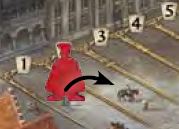 Each player now has the opportunity to advance 1 step on the reputation track
by paying the number of guilders equal to the sum of the values of all dice of value 1 or 2.
Each player now has the opportunity to advance 1 step on the reputation track
by paying the number of guilders equal to the sum of the values of all dice of value 1 or 2.
The start player goes first. If he wishes to advance, he pays the sum in guilders to the bank
and advances his pawn by one step.
Example:
The red player wants to advance. He pays 3 guilders and advances his pawn one step in front of the town hall.
Note: The first time a player advances, he will take his pawn from the
town hall and put it on step 1 of the reputation track.
In clockwise order the other players get the same opportunity to advance.
If a player does not have enough guilders to pay for an advancement then he cannot advance.
A player may advance only once per round.
If there are no dice of value 1 or 2 then players cannot advance.
Note: Dice of value 3 or 4 have no special effect during this phase.
General rules for this phase:
Each player begins this phase with 5 cards in hand.
In turn each player plays one card from his hand to do 1 of the 6 possible actions.
- Take 2 workers
- Take 1-6 guilders
- Discard 1 threat marker
- Build 1 canal token
- Build 1 house
- Recruit 1 Person
Continue until each player has played 4 cards from his hand.
Then this phase ends.
Description of the actions:
This is the main part of each round.
General rules for this phase:
- Each player begins this phase with 5 cards in his hand.
-
In turn each player plays one card from his hand to do 1 of the 6 possible actions.
-
This continues until each player has played 4 cards from his hand, and thus has performed 4 actions.
(The 4 actions can be the same or different.)
- Then this phase ends.
The start player begins by playing 1 card from his hand.
With the played card he performs 1 of the following 6 actions:
- Take 2 workers
- Take 1-6 guilders
- Discard 1 threat marker
- Build 1 canal token
- Build 1 house
- Recruit 1 Person
After the start player has played 1 card and performed 1 action, the other players in clockwise order also
play 1 card and perform 1 action. This continues until each player has played 4 cards from his hand, and
thus has performed 4 actions.
Note: Since it is possible for a player to lose cards from his hand, it is possible that he has no hand cards when it is his turn to play one.
In that case he still gets a turn since he might have persons he could activate.
Then this phase ends. Usually players will each have 1 card in hand at this point.
Anatomy of a card
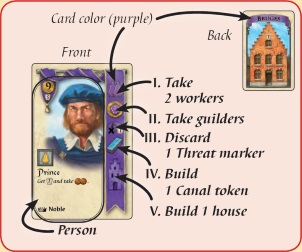
Card color
There are 5 different card colors (blue, brown, red, purple and yellow).
The front and back of each card shows its color.
Actions
The first 5 actions are depicted on the banner found on the right hand side of each card.
Except for the color, these 5 actions are the same on every card.
Person
The person section of each card shows a different character.
Each person has a different price, special effect, and group.
The details of the person section are explained below.
The actions are:
I. Take 2 workers

The player places a card face up on the discard pile and takes 2 workers of the color of the card.
He places the workers in his play area.
Example:
The player plays 1 red card and takes 2 red workers.

The player places a card face up on the discard pile and takes 2 workers of the color of the card.
He places the workers in his play area.
Workers are not limited by the components. If you run out of a color of worker, use replacement pieces you deem appropriate.
II. Take 1–6 guilders

The player places a card face up on the discard pile and takes the number of guilders from the bank
equal to the value of the die of the color of the played card.
He places the guilders in his play area.
Example:
The player plays 1 yellow
card and takes 6 guilders, which
corresponds to the value of
on the yellow die.

The player places a card face up on the discard pile and takes the number of guilders from the bank
equal to the value of the die of the color of the played card.
He places the guilders in his play area.
Guilders are not limited by the components.
III. Discard 1 threat marker and score 1 point

The player places a card face up on the discard pile, discards 1 threat marker of the color of the played card,
and scores 1 point.
Example:
The player discards 1 brown card. He discards 1 brown threat marker and scores 1 point.

The player places a card face up on the discard pile, discards 1 threat marker of the color of the played card,
and scores 1 point.
Note: A player scores 1 point for each threat marker he discards by playing a card or by
activating a person, e.g. the Jailer.
IV. Build 1 canal token
Each player has 2 canal sections of 5 spaces each. He can build on the 10 canal spaces.
A player can build only on a canal space that is adjacent to his guard house or a previously built canal space.
The player places a card of the color of the canal space he wants to build on face up on the
discard pile and pays the number of guilders shown on that canal space.
He then places a canal token on that canal space.
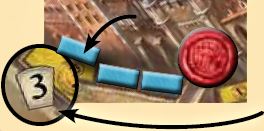 At the end of the game, a player scores 3 points for each built canal space 3.
At the end of the game, a player scores 3 points for each built canal space 3.
 When a player completely builds a canal section he takes the topmost statue token.
He will score the points printed on the statue token at the end of the game.
When a player completely builds a canal section he takes the topmost statue token.
He will score the points printed on the statue token at the end of the game.

Example:
The player plays 1 blue card and pays
1 guilder to place a canal token on the blue
space adjacent to his seal.
Each player has a guard house that bears his small seal.
To the left (clockwise) and right (counter-clockwise) of the guard house are two canal sections consisting of 5 canal spaces each.
A canal section must be built one space at a time starting with with the space adjacent to the guard house and proceeding away from the guard house.
A canal can be built on either canal section until the section has been completely built.
The player places a card of the color of the canal space he wants to build on face up on the
discard pile and pays the number of guilders shown on that canal space.
He then places a canal token on that canal space.
 At the end of the game, a player scores 3 points for each built canal space 3.
No points are scored if the canal space 3 was built but its canal token was later discarded.
At the end of the game, a player scores 3 points for each built canal space 3.
No points are scored if the canal space 3 was built but its canal token was later discarded.
 When a player completely builds a canal section he takes the topmost statue token.
He will score the points printed on the statue token at the end of the game.
When a player completely builds a canal section he takes the topmost statue token.
He will score the points printed on the statue token at the end of the game.
V. Build 1 house
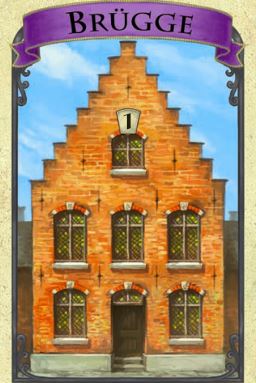
The player places a card face down in front of himself and pays 1 worker of the color of the card.
The card is now a house.
At game end players score 1 point for each of their houses.
Example:
The player plays 1 purple card face down in
front of himself. He returns one purple worker.

The player places a card face down in front of himself and pays 1 worker of the color of the card.
The card is now a house.
Each house can accommodate one person (see next action).
At game end players score 1 point for each of their houses.
VI. Recruit 1 person
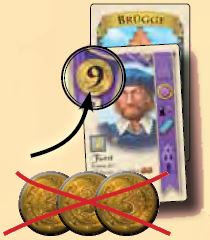
The player places a card face up on one of his empty houses leaving the color of the house visible
and pays the number of guilders shown on the card.
The person card color and house color may be different.
The person has now been recruited and can be activated to get the benefit written on the card.
Example:>
The player has an empty house. To recruit the Prince he
places the Prince card onto that house and pays 9 guilders to the bank.
The player places a card face up on one of his empty houses leaving the color of the house visible
and pays the number of guilders shown on the card to the bank.
The person card color and house color may be different.
Each house can accommodate only 1 person.
A player may activate his persons to receive various benefits.
Before explaining how a person is activated, let's take a closer look at the details of a person card.
Person section of a card
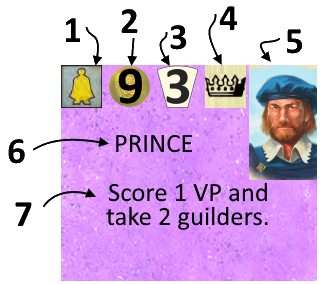
The information on the cards of Yucata is rearranged:
- Activation icon (worker, once per round, unlimited, immediate, or game end)
- Cost to recruit
- Game end points
- Person group
- Portrait
- Name
- Activation benefit
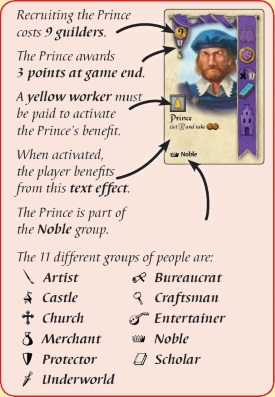

Price: The top left corner of a card shows the price in guilders that must be paid to recruit the person.
Points: The small number located below the price is the number of points that the person's owner
scores at game end if the person is in a house.
The points are always one third of the price.

Activation icon: This icon, located to the left of the person's portrait,
indicates when and how that person is activated. The different icons are explained below.

Name and benefit: Under the activation icon is the person's name and the benefit gained by activating the person.

Group: Each person belongs to one of 11 groups. The benefits of some cards refer to a group.

The information on the cards of Yucata is rearranged:
- Activation icon (worker, once per round, unlimited, immediate, or game end)
- Cost to recruit
- Game end points
- Person group
- Portrait
- Name
- Activation benefit
Activating a person
During a player's turn he may activate one or more of his persons.
The type of activation is indicated by the activation on the card as follows:
Activating a person gives the player the benefit described on the card.
During a player's turn he may activate one or more of his persons.
Persons with the "arrow" icon  are activated immediately after being recruited.
are activated immediately after being recruited.
Persons with a "worker" icon  or
"one" icon or
"one" icon  are activated during the player's turn in phase 3. are activated during the player's turn in phase 3.
Persons with an "infinity" icon  are activated during the player's turn in various phases. are activated during the player's turn in various phases.
Persons with the "laurel" icon  are activated during final scoring at the end of the game.
are activated during final scoring at the end of the game.
The "one" icon  is used on Yucata on some cards for better clarification
instead of the "infinity" icon 
The 5 icons in more detail:
Persons with the "arrow" icon  give an immediate one-time benefit when they are recruited.
give an immediate one-time benefit when they are recruited.
Example:
The player recruits the Alchemist and immediately takes 6 guilders from the bank.
 Persons with the “arrow” icon give a one-time benefit immediately after they are recruited.
These persons can not be activated again during the game unless they
are returned to a player’s hand and recruited again.
Persons with the “arrow” icon give a one-time benefit immediately after they are recruited.
These persons can not be activated again during the game unless they
are returned to a player’s hand and recruited again.
Persons with a "worker" icon  can be activated once per round by paying a worker of the specified color.
can be activated once per round by paying a worker of the specified color.
Example:
The player activates the Servant by playing a red worker.
The Servant allows the player to draw 1 card.
 Persons with the “worker” icon can be activated once per round by paying a worker of
the color depicted in the icon. The worker color is not necessarily the color of the person.
Persons with the “worker” icon can be activated once per round by paying a worker of
the color depicted in the icon. The worker color is not necessarily the color of the person.
To show that a person with a "worker" icon has been activated during the current round, rotate the person by 90°.
Persons with the "one" icon  can be activated once per round at no cost.
can be activated once per round at no cost.
Example:
Activating the Accountant allows the player to take 2 guilders.
 Persons with the “one” icon can be activated once per round like persons with a "worker" icon.
The text on these cards will usually say "once per round".
Persons with the “one” icon can be activated once per round like persons with a "worker" icon.
The text on these cards will usually say "once per round".
Activating a person of this type costs nothing.
To show that a person of this type has been activated during the current round, rotate the person by 90°.
Persons with the "infinity" icon  are activated
every time the triggering action is performed or the triggering game situation occurs. are activated
every time the triggering action is performed or the triggering game situation occurs.
 Persons with the "infinity" icon are activated
every time the triggering action is performed or the triggering game situation occurs.
Persons with the "infinity" icon are activated
every time the triggering action is performed or the triggering game situation occurs.
Example:
Whenever the player with the Lawyer does the “take 2 workers” action, he takes 3 workers instead.
Persons with the "infinity" icon that improve an action for the player are activated automatically
every time (possibly more than once per round) the player performs the triggering action.
Example:
The player with the Inventor may refill his hand to 6 cards rather than the usual 5 during phase 1.
This gives him 1 extra card to choose from.
Persons with the "infinity" icon that give a benefit in various situations,
e.g. when drawing cards or advancing, are activated automatically every time (possibly more than once per round)
the triggering situation occurs.
Note: Since they can be activated an unlimited number of times,
do not rotate persons with the "infinity" icon by 90° when they are activated.
Persons with the "laurel" icon  are activated only during final scoring. are activated only during final scoring.
Example:
The Bishop is automatically activated during the final scoring.
For every 2 workers in the player's play area, the player scores 1 point.
 Persons with the "laurel" icon are activated only during final scoring at the end of the game.
They are activated automatically. The player scores the number of points specified by the text on the card.
Persons with the "laurel" icon are activated only during final scoring at the end of the game.
They are activated automatically. The player scores the number of points specified by the text on the card.
General information:
Activating a person gives the player the benefit described on the card.
A person that can be activated during phase 3 can be activated before or after playing a card.
A person can be activated during the turn in which it was recruited.
Activating a person can alter the normal rules.
General information:
A person with a "worker" icon  or the "one" icon
or the "one" icon  ) can be activated before or after playing a card during phase 3.
A player can activate some persons before playing a card and some after. ) can be activated before or after playing a card during phase 3.
A player can activate some persons before playing a card and some after.
A person with a "worker" icon  or the "one" icon
or the "one" icon  ) can be activated during the turn in which it was recruited. ) can be activated during the turn in which it was recruited.
Activating a person can alter the normal rules.
Example of activating a person that alters the normal rules:
The player activates the Coachman by returning a yellow worker to the supply.
The Coachman allows the player to immediately play another card from his hand,
thereby letting him perform another action during the same turn, which is contrary to the normal rules.
The player now has one fewer card in his hand. He will end the round with no cards in his hand instead of the usual 1 card.
At the beginning of the next round he will refill his hand to 5 cards as usual.
Note: The benefits of most cards are self-explanatory.
However, some combinations and special cases are explained in the rules supplement.
Players determine whether any of them has any of the three majorities.
If so then each player with a majority flips his corresponding majority marker(s) colored side up.
Players determine whether any of them has any of the three majorities.
If so then each player with a majority flips his corresponding majority marker(s) colored side up.
Reputation
 If a single player occupies the most advanced position on the
reputation track (i.e. is on a higher number than any other player), that
player may flip his reputation majority marker colored-side up.
If a single player occupies the most advanced position on the
reputation track (i.e. is on a higher number than any other player), that
player may flip his reputation majority marker colored-side up.
Example:
Red is alone in front of the other players on the reputation track.
He flips his reputation majority marker colored side up.
If a single player occupies the most advanced position on the
reputation track (i.e. is on a higher number than any other player), that
player may flip his reputation majority marker colored-side up.
Persons
 If a player has more persons in his play area than any other player,
he may flip his person majority marker colored side up. The
number of persons is compared with every other player individually.
A player need not have more persons than every other player combined.
If a player has more persons in his play area than any other player,
he may flip his person majority marker colored side up. The
number of persons is compared with every other player individually.
A player need not have more persons than every other player combined.
Example:
Blue has 6 persons in his play area, Yellow has 5 and Red and Green both have
4 persons. Blue gets to flip his person majority marker colored side up.
If a player has more persons in his play area (i.e. in houses) than any other player,
he may flip his person majority marker colored side up. The
number of persons is compared with every other player individually.
A player need not have more persons than every other player combined.
Canal
 If a player, counting both of his canal sections, has built more
canals than any other player, he may flip his canal majority marker colored side up.
If a player, counting both of his canal sections, has built more
canals than any other player, he may flip his canal majority marker colored side up.
For all 3 majorities:
-
A player must have more than any other player, at the end of a round.
-
Once flipped, a majority marker stays colored side up for the rest of the game.
-
If another player surpasses a majority holder then that player also flips his corresponding majority marker.
Example:
Green has built a total of 7 canals, Red 6, Green 2 and Blue none.
Green gets to flip his canal majority marker colored side up.
If a player, counting both of his canal sections, has built more
canals than any other player, he may flip his canal majority marker colored side up.
For all 3 majorities:
Example:
Red and Yellow both share the most advanced position on the reputation track.
No player is allowed to flip his reputation majority marker this round.
-
Majorities are checked only at the end of a round.
If a player gains a majority during a round but no longer has it at the end of the round then he does not get to flip his corresponding marker.
-
A player must have a clear majority, i.e. more than any other player, to be able to flip his marker colored side up.
-
Once flipped, a majority marker stays colored side up for the rest of the game.
A flipped marker indicates that the player had the corresponding majority at the end of some round during the game.
-
If another player surpasses a majority holder then that player also flips his corresponding majority marker.
At the end of the game more than one player can score for a particular majority.
Change the start player
After verifying majorities pass the start player banner clockwise to the next player. The next round begins.
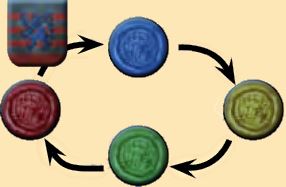
After verifying majorities pass the start player banner clockwise to the next player. The next round begins.
The game ends at the end of the round in which one of the draw piles was emptied (the following round if emptied during the actions phase).
Each player then scores points for:
Persons
For each of his (recruited) persons the player scores the number of game end points indicated on the card.
Houses
For each house the player scores 1 point.
Game end persons
For each person with a "laurel" icon the player scores the number of points specified by the text on the card.
Majority markers
For each colored side up majority marker the player scores 4 points.
Canal
The player scores 3 points for each built canal space 3 in his two canal sections.
For each collected statue the player scores the number of points indicated on the statue.
Reputation
The player scores the number of points indicated on the step of the reputation track he has reached.
The player with the most points wins the game.
In case of a tie, the tied player with the most guilders is the winner.
Multiple tied players with the most guilders all win.
The game ends at the end of the round in which one of the draw piles was emptied (the following round if emptied during the actions phase).
Each player then scores points for:
Persons
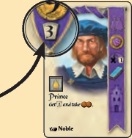 For each of his (recruited) persons the player scores the number of game end points indicated on the card.
For each of his (recruited) persons the player scores the number of game end points indicated on the card.
Houses
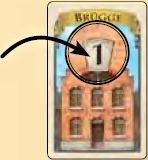 For each house the player scores 1 point whether on not the house is occupied.
For each house the player scores 1 point whether on not the house is occupied.
Game end persons
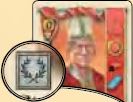 For each person with a "laurel" icon the player scores the number of points specified by the text on the card.
For each person with a "laurel" icon the player scores the number of points specified by the text on the card.
Majority markers
 For each colored side up majority marker the player scores 4 points.
For each colored side up majority marker the player scores 4 points.
Canal
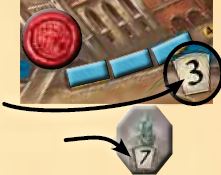 The player scores 3 points for each built canal space 3 in his two canal sections.
For each collected statue the player scores the number of points indicated on the statue.
The player scores 3 points for each built canal space 3 in his two canal sections.
For each collected statue the player scores the number of points indicated on the statue.
Reputation
 The player scores the number of points indicated on the step of the reputation track he has reached.
The player scores the number of points indicated on the step of the reputation track he has reached.
The players move their pawns around the scoring track to note their scores.
When a player has over 50 points, he takes a 50/100 points token and continues moving his pawn around the track.
If a player ever has over 100 points, he flips his token to indicate his score.
The player with the most points wins the game.
In case of a tie, the tied player with the most guilders is the winner.
Multiple tied players with the most guilders all win.
Setup
The 17 pet cards are shuffled together with the rest of the cards.
 Each player receives a pet majority marker of his color, which he places gray side up at the start of the game.
Each player receives a pet majority marker of his color, which he places gray side up at the start of the game.
The 17 pet cards are shuffled together with the rest of the cards.
The game setup is carried out as described in the base game rules.
With the 17 additional cards the deck is slightly larger.
However, that will have no serious impact on the game.
The game might last a round longer.
 Each player receives a pet majority marker of his color, which he places gray side up at the start of the game.
Each player receives a pet majority marker of his color, which he places gray side up at the start of the game.
The pet cards
The 17 pets belong to a new
person group called "Pets"  . .
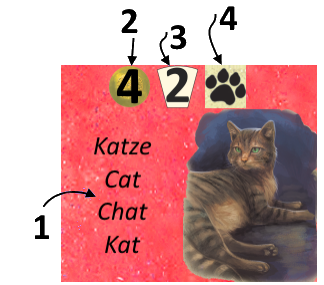
- Name
- Cost
- Game end points
- Person group
Pet cards can be used for any of the 6 actions.
Rules and cards that refer to "persons" also apply to pets. Exceptions are explained below.
For better visual distinction. the sky on the backs of Yucata pet cards is orange.
- Cost to recruit
- Game end points
- Name
- Person group
- Actions
The 17 pets belong to a new
person group called "Pets"  . .
The layout of pet cards is essentially the same as the layout of person cards.
Each pet card can be used for the same 6 actions as person cards.
For better visual distinction, the sky on the backs of Yucata pet cards is orange.
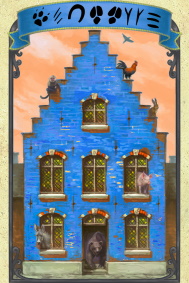
Like a person card, a pet card can be played as a house which scores 1 point at the end of the game.
Persons can be recruited, as usual, into a pet house.
Pets are persons too
Rules and cards that refer to "persons" also apply to pets.
Exceptions are explained below.
Note: The Watchdog from the base game is still considered to be a person, not a pet.
New rules
Action 6 - Recruit a person
Each house can be occupied by 1 person AND 1 pet.
Threats
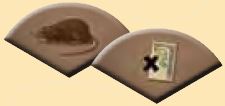 Plague: The player may discard a pet instead of a person.
Plague: The player may discard a pet instead of a person.
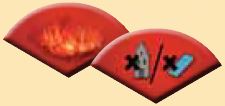 Fire: When a player discards a house, all inhabitants, including a pet, are returned to his hand.
Fire: When a player discards a house, all inhabitants, including a pet, are returned to his hand.
Activation
Unlike persons, pets have no function and cannot be activated.
There are a few small new rules.
Action 6: "Recruit 1 person"
A pet may be recruited into an empty house or one with a
person already there. If a pet is recruited into an empty house,
a person can be recruited later into that house as well.
Each house may thus be occupied by 1 person AND 1 pet.
The person should be placed on top of the pet so the person’s function remains visible.
Notes regarding threats:
 Plague: The player may discard a pet instead of a person.
Plague: The player may discard a pet instead of a person.
 Fire: When a player discards a house, all inhabitants, including a pet, are returned to his hand.
Fire: When a player discards a house, all inhabitants, including a pet, are returned to his hand.
Pets cannot be activated
Unlike persons, pets have no function and cannot be activated.
Pets are simply there to provide milk, lay eggs, and keep their humans company.
Phase 4: Verifying majorities
After checking the 3 majorities of the base game, check the pet majority.
If a player has more pets in his play area than any other player then he flips his pets majority marker colored side up.
Check the 3 base game majorities as usual.
Note: Pets do not count toward the person majority.
Then check for a pet majority.
If a player has more pets in his play area (i.e. in houses) than any other player then he flips his pets majority marker colored side up.
Game end points
In addition to the points from the base game, the player scores the game end points shown on his pet cards.
Pets have a higher game end point to cost ratio than persons (1/2 instead of 1/3).
This expansion consists of four independent modules that can be used individually or in combination.
Note: If playing with 5 players, the additional person cards from module 1 are required.
Module 1: New Citizens – Additional person cards including a new group
Module 2: 5th Player – Board and components for a 5th player
Module 3: The Zwin – New actions and boats for canal building
Module 4: Stock Exchange – Cards that modify existing actions
This expansion consists of four independent modules that can be used individually or in combination.
Module 1: New Citizens – Additional person cards including a new group
Module 2: 5th Player – Board and components for a 5th player
Module 3: The Zwin – New actions and boats for canal building
Module 4: Stock Exchange – Cards that modify existing actions
Note: If playing with 5 players, the additional person cards from module 1 are required.
Components
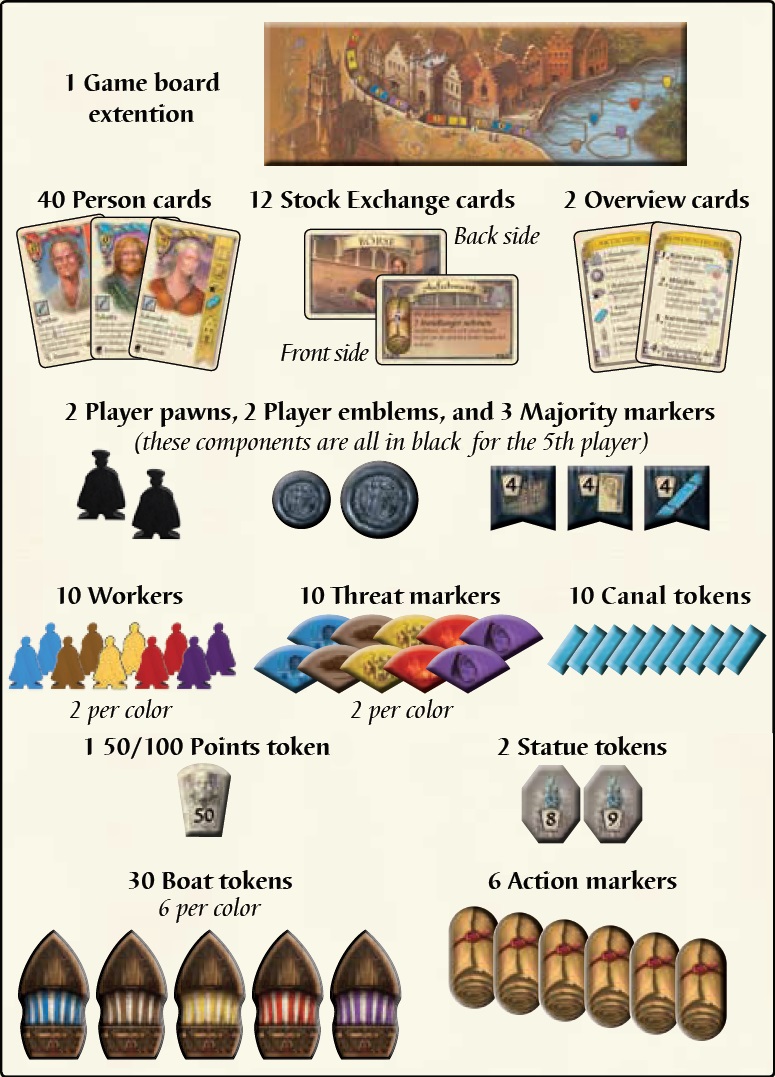 Note: This expansion includes no additional guilders.
The guilders contained in the base game are sufficient.
Note: This expansion includes no additional guilders.
The guilders contained in the base game are sufficient.
New Citizens – Additional person cards including a new group
The module consists of 40 new person cards:
- 2 new person cards in each of the 11 groups of the base game
-
a new 17-card group "Travelers"

- 1 updated Engraver card
New residents and visitors from distant countries enrich life in Brügge.
Components:
This module consists of 40 new Person cards:
22 new person cards
There are 2 new person cards for each of the 11 groups of the base game.
Each group now contains 17 persons (15 from the base game and 2 new ones).
17 "Traveler" cards
There is a new person group called "Travelers"  .
Like the other groups it contains 17 cards. .
Like the other groups it contains 17 cards.
1 updated Engraver card
At the request of some players we slightly changed the Engraver card from the first edition of the basic game.
The new Engraver scores only 1 point per group of persons and costs 9 guilders.
Owners of the first edition can remove the original Engraver from the game and use the new Engraver instead.
Note: Do not use both the old and new Engravers in a game.
Yucata always uses the new Engraver.
Divide the shuffled person cards into 6 stacks.
Combine as many stacks as there are players into one large stack.
Split that stack in two to form the draw piles.
Set the remaining stacks aside as an extra stack to replace the first draw pile that is emptied.
Setup
Shuffle the new cards with those from the base game.
Divide the shuffled cards into 6 approximately equal stacks (1 stack more than in the base game).
Take 1 stack per player and shuffle them together into 1 large stack.
Divide the large stack into 2 approximately equal piles. These are the two draw piles.
Combine the remaining stacks and set them aside as an extra stack that will be used when a draw pile is emptied.
How do the New Citizen cards function?
The cards have the same features as the cards of the basic game.
They can be played to take any of the 6 possible actions.
Some of the new citizens allow a player to pick a card from the discard pile:
-
12 (1 for each person group) let the player put a discarded person of a specified group into an empty house for free.
-
5 of the Travelers let the player play a discarded card as a house for 1 worker of the card's color.
5 of the Travelers let the player specify the color used for the action of the next card he plays.
The cards have the same features as the cards of the basic game.
Each of the cards can, as in the base game, be used for any the 6 possible actions.
Only the persons on the cards are new.
Cards from the discard pile
Some of the new persons allow a player to choose a card from the discard pile.
Depending on the size of the discard pile, this can take some time to complete.
To keep the game from slowing down, the players may look through the discard pile at any time.
A player may do this even if it is not his turn, and even if he has no such person cards in his hand.
Details of the new cards
Brewer, Court Marshal, Duchess, Finn, Fortune Teller, Gauger, Hangman, Model,
Navigator, Prior, Provost and Scout:
These 12 (1 for each person group) let the player put a discarded person of a specified group into an empty house for free.
Using the Brewer as an example:
A player can search through the discard pile before he activates the Brewer to see which Craftsman persons are in the pile.
The player must have an empty house in his play area in which to put the chosen Craftsman person.
The player does not pay any guilders to put the Craftsman person into a house.
The player can activate the newly recruited Craftsman person according to the usual rules.
Egyptian, Dane, Englishman, Greek and Italian:
These 5 let the player choose a card from the discard pile and play it as a house.
The player must pay the usual price of 1 worker of the color of the played card.
The player can search through the discard pile before he activates the card.
Frenchwoman, Norwegian, Portuguese, Russian and Spaniard:
These persons all have the same benefit.
The player can activate one of these persons before playing a card.
When he plays the card he can perform an action as if the card were the color of his choice.
Barterer: (once per round) Return 1 worker to take the number of guilders equal to the value of the die of the worker's color.
Executioner: (worker) Put a worker on the Executioner. At game end score 1 point per worker on the Executioner.
German: (worker) Take 2 guilders for each Traveler person.
Glass Painter: (worker) Score 1 point per Traveler person.
Hungarian: (worker) Take 1 guilder for each different colored worker.
Lay Brother: (worker) Take 1 worker of the die color for each value 1 die.
Master of Ceremonies: (worker) Draw and play the top discarded card.
Militia: (unlimited) Choose a color before dice are rolled in Phase 2. Take no threat marker of that color.
Milord: (immediate) Move any number of your persons from houses to your hand.
Persian: (unlimited) Score 1 point every time you advance on the reputation track.
Puppeteer: (worker) Activate a once per round or worker person a second time this round.
Saboteur: (immediate) Draw a card from every other player's hand.
Scotsman: (immediate) Take 2 guilders for each different threat color.
Strategist: (immediate) Give every other player one of your threats.
Swede: (immediate) Activate an immediate, worker, or once per round person of another player.
Swiss: (game end) Score 2 points per Traveler person.
Tanner: (immediate) Return up to 5 workers of different colors. Score 1 point and take 1 guilder for each.
This module contains components for a 5th player.
The rules are the same as in a 2-4 player game.
Module 2: 5th Player - Board and components for a 5th player
The thriving metropolis attracts more trading families.
Components and setup
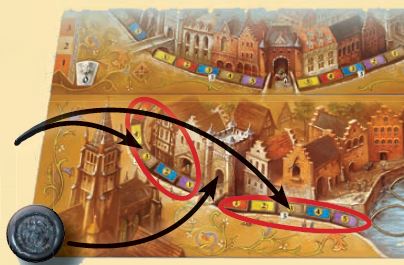
The game board extension is placed below the base game board.
The left side of the extension shows 2 new canal sections for the 5th player.
The 5th player places his small seal in the round box above the guard house between the two canal sections.
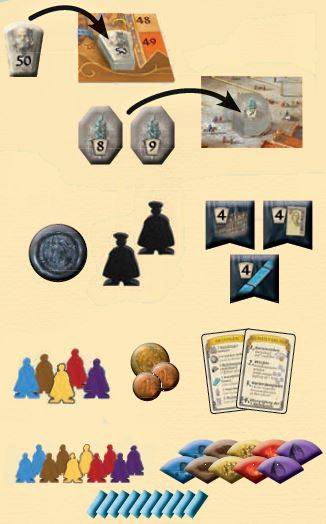 The additional 50/100 points token is placed with the others on the game board. The two
new statue tokens with the values 8 and 9 are placed on the stack with the other statue tokens,
so that the token with the value 9 is on top.
The additional 50/100 points token is placed with the others on the game board. The two
new statue tokens with the values 8 and 9 are placed on the stack with the other statue tokens,
so that the token with the value 9 is on top.
The other components for the 5th player (1 large seal, 2 player pawns and 3 majority markers
in black) are set up the same way as for the other players (as in the base game).
The 5th player also receives the usual “basic components” (1 worker in each of the 5 colors,
5 guilders and 2 overview cards).
The rest of the additional workers, threat markers and canal tokens are placed in the general supply.
How is the game played with a 5th player?
The rules are the same as in a 2-4 player game.
When a player builds a canal he can immediately buy a boat action.
The available boat actions change every round and are displayed on the boats.
In Phase 2 "Roll the dice" before the "Distribute threat markers" and "Advance 1 reputation step" steps,
perform the new step "Determine boats":
For each die of value 3 or 4, place the topmost boat of the color of the die on the same colored berth.
Boats in a berth can be used by the players during the current round.
They are removed at the end of the round.
Using the boats
When a player plays a card to perform the action "Build 1 canal token" during phase 3,
after completing that action he may also use one of the active boats.
The boat does not have to be the same color as the played card.
The player pays a worker of the boat color and immediately performs the additional action depicted on the boat.
Module 3: The Zwin – New actions and boats for canal building
This module makes canal building more beneficial.
Whenever a player builds a canal, he can immediately buy a boat action.
The available boat actions change each round and are shown on the boats.
Components and setup

The game board extension is placed below the base game board.
The right side of the extension shows berths for the 5 boats.
The 30 boat tokens are sorted by color. The 6 boat tokens of each color are then
shuffled and placed face down in 6 stacks next to the game board extension.
Then the top token from each stack is turned face up on top of the stack so
that its action symbol is visible.
How is "The Zwin" module played?
In Phase 2 "Roll the dice", after the "Distribute threat markers" and "Advance 1 reputation step" steps,
perform the new step "Determine boats".
On Yucata the "determine boats" step is performed before those steps, i.e. immediately after rolling the dice.
Additional step: Determine boats
Example:
The blue die shows a 3, and the yellow cube shows a 4.
The top boat tokens from the blue and yellow stacks are moved to the blue and yellow berths.
For each die of value 3 or 4, place the topmost boat of the color of the die on the same colored berth.
Boats that are in a berth are active, i.e. they can be used by the players during the current round.
For each stack from which a boat token was moved to its berth, the new top boat token is turned face up.
Thus, players can always see which boats may become active in future rounds.
Boat tokens that were not moved to a berth remain face up on their stacks for future rounds.
Using the boats
Whenever a player performs a “build 1 canal token” action from a played card in Phase 3,
he may (after he has performed the card action) also perform the action of one of the active boats.
Note: A player may use a boat action only when he builds a canal token by playing a card.
He may not use a boat action when he builds a canal in another manner such as by activating a recruited person.
The player decides which of the active boats he wants to use.
The boat does not have to be the same color as the played card.
Example:
In this round the blue and yellow boats are active.
The player decides to use the yellow boat.
He returns a yellow worker to the general supply and takes 1 purple and 2 blue workers
(as allowed by the "take 3 workers" action of the yellow boat).
The player pays a worker of the color of the boat and immediately performs the additional action depicted on the boat.
The boat remains available for use by all players.
The individual additional actions of the boats are described in detail below.
At the end of the round the active boats are removed from the berths and put into discard piles.
If the stack of a color of boats becomes empty, shuffle the discarded boats of that color and make a new stack from them.
The actions of the boats
Take 3 workers
The player takes 3 workers of any colors from the general supply and places them in his play area.
Discard 2 threat markers
The player discards up to 2 threat markers from his play area back into the general supply.
He scores 1 point for each threat marker he discards.
Take 6 guilders
The player takes 6 guilders from the general supply and places them in his play area.
Activate 1 "immediate use" person
The player immediately activates one of his recruited persons that has an “immediate use” arrow icon on it.
Additional card action
The player draws one card from one of the draw piles and performs one of its actions immediately.
Advance 1 reputation step
The player advances his pawn 1 step on the reputation track.
Each round, one of the 6 possible card actions is modified.
Each of these modifications, however, can only be used a limited number of times per round.
Phase 1: Draw cards
In each round after all players have filled their hands, the top stock exchange card is turned face up.
The number of action tokens specified on the card (5 or 6) are placed on top of the card.
Phase 3: Play cards and perform actions
If when a player plays a card he performs the action indicated on the current stock exchange card,
he may use the modification described on the stock exchange card. (Activating a person does not let a player use a stock exchange card.)
Each time a stock exchange card is used, one of the action tokens is removed from it.
If the last action token is removed, the stock exchange card is discarded and no stock exchange modifications are available for the rest of the round.
Phase 4: Verify majorities and change the start player
If there are still any action markers on the stock exchange card, remove them from the card and discard the card.
In the next round, a new stock exchange card will be revealed.
Module 4: Stock Exchange – Cards that modify actions
Each round, one of the 6 possible card actions is modified.
Each of these modifications, however, can only be used a limited number of times per round.
Components and setup
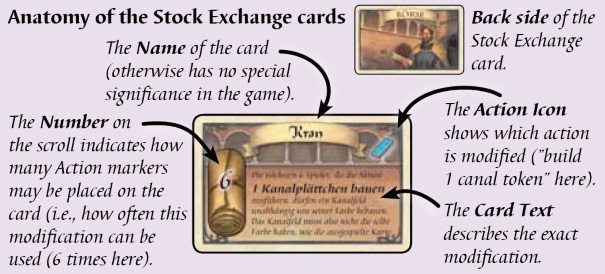
The 12 Stock Exchange cards are shuffled and placed face down in a stack next to the board, readily visible to all players.
The 6 Action markers are placed next to the board.
How are the Stock Exchange cards played?
The following sections describe the changes to the various phases of the base game.
Phase 1: Draw cards
In each round, after all players have refilled their hands, reveal the top Stock Exchange card.
Place the number of action marker specified (5 or 6) onto the card.
If only 5 action markers are specified, the 6th marker remains next to the card stack.
Note: Yucata provides the unofficial variant of reducing the number of action markers placed on stock exchange cards by five minus the number of players.
This module does not change Phase 2.
Phase 3: Play cards and perform actions
Example:
The Price Fixing stock exchange card specifies the action "take 1-6 Guilders".
The player plays a purple card and chooses to perform that action.
The purple die shows a 1 in this round, so the player would normally get 1 guilder.
However, by using the Price Fixing stock exchange card he gets 5 guilders instead of 1.
Each stock market card specifies one of the 6 card actions.
When a player plays a card and performs the specified action, he may use the modification
shown on the stock exchange card.
Note: The player may use a stock exchange card only if he performs the action by playing a card.
He may not use one if he carries out an action in another way, e.g. by activating a person.
If he uses the modification, he removes an action marker from the card.
If the last action token is removed, the stock exchange card is discarded and no stock exchange modifications are available for the rest of the round.
Only in the next round will a new stock exchange card be revealed.
Phase 4: Verify the 3 majorities and change the start player
If there are still any action markers on the stock exchange card in Phase 4, they are now removed from the card,
and the card is placed back in the box.
In the next round, a new stock exchange card will be revealed.
List of Stock Exchange cards
Building Materials: When you build a canal pay 2 fewer guilders.
You cannot use this card when you use the Well Builder to build a canal for free.
Cabin: When you build a house don't pay a worker.
Contingency Plan: When you discard threat(s) discard any color(s).
You cannot use this card when you discard threat(s) of the color of the played card or
when you use the Frenchwoman, etc. to discard 1 threat of any color or 2 threats of the same color.
Crane: When you build a canal build any color canal.
You cannot use this card when you build a canal of the color of the played card.
Economic Boom: When you take workers take an extra worker of the same color.
You can use this card together with the Lawyer to take a total of 4 workers.
Initiative: When you recruit an immediate, once per round, or worker person do a free extra activation.
Insurance: When you discard threat(s) score 1 more point for each.
Jack-of-all-Trades: When you take workers choose their colors.
You cannot use this card when you take workers of the color of the played card or
when you use the Frenchwoman, etc. to take workers of the same color.
Magnificent Building: When you build a house score 1 point.
Motivation: When you recruit draw a card.
If the recruited person is immediate, draw the card before activating the person.
Price Fixing: When you take guilders take 5 guilders.
This card has the effect of changing the die value.
You cannot use this card with a die of value 5.
The possible 3 extra guilders from the Draper, etc. are in addition to the 5 from this card.
Profiteering: When you take guilders take 2 extra guilders.
The possible 3 extra guilders from the Draper, etc. are in addition to the 2 extra from this card.
Acrobat (Bard, Comedian, Dancer and Minstrel are identical):
Build a canal without playing a card for double the normal price.
If you have activated but not yet used the Well Builder (once per round pay nothing when build a canal) this round
then the canal built by activating the Acrobat will be free.
Actor: Activating the Actor lets you activate for free all of your unactivated persons that normally cost a worker to activate.
You can activate as many of those persons as you want in any order you want.
If activating one person leads to losing (i.e. discarding or returning to your hand) a person you had when you activated the Actor or to recruiting a person, you cannot activate the lost or recruited person.
Recursively activating the Actor has no effect.
Apothecary: Four instead of three threats of a color are required for you to suffer damage.
If you have three threats of a color and lose (i.e. discard or return to hand) the Apothecary, you immediately suffer the damage.
Arsonist: Each opponent takes 1 red threat.
The Bandit, Mountebank, Smuggler and Swindler make opponents take 1 yellow, brown, blue and purple threat, respectively.
If activating any of these persons causes at least one opponent to have three threats of a color (four for an opponent who has the Apothecary),
then unless you undo the activation you must interrupt your turn to let the opponent(s) resolve the threats.
After you click the "Finish turn" button to interrupt your turn, you will no longer be able to undo the activation.
Assassin: Each opponent must discard a person if he has one.
If any opponent has a person then unless you undo the Assassin activation you must interrupt your turn to let the opponent(s) choose which person to discard.
After you click the "Finish turn" button to interrupt your turn, you will no longer be able to undo the activation.
Astronomer: The Astronomer is automatically activated whenever you put an immediate one-use person, i.e. a person with an "arrow" icon, into a house.
Usually a person is put into a house via the recruit action, but it can also be done by activating the New Citizens cards that let a player put a discarded card into a house (e.g. the Brewer).
When the Astronomer is activated you may activate the immediate person a second time.
The Astronomer is NOT activated when activating an immediate person that is already in a house, e.g. when performing the "activate an immediate person" boat action.
If the Initiative stock exchange card (allows a free extra activation of a person being recruited) is available,
you may activate the recruited person three times: first the normal activation, then an optional activation from the Astronomer, and finally an optional activation from the Initiative card.
Bandit: See Arsonist.
Bard: See Acrobat.
Beggar: Each opponent must give you 2 workers from his play area if he has them.
If an opponent has only 1 worker, he must give you that worker.
Each opponent chooses which workers to give you.
If any opponent has a worker then unless you undo the Beggar activation you must interrupt your turn to let the opponent(s) choose which workers to give you.
After you click the "Finish turn" button to interrupt your turn, you will no longer be able to undo the activation.
Brewer: Choose a discarded Craftsman card and put it in an empty house for free.
The Court Marshal, Duchess, Finn, Fortune Teller, Gauger, Hangman, Model, Navigator, Prior, Provost and Scout let you do the same for cards of other groups.
This effect is NOT considered a recruit action, so it does not activate the Fire-eater or let you use an Initiative or Motivation stock exchange card.
However, if the chosen discard is an immediate activation card, putting it in an empty house does trigger its immediate activation.
It will also activate the Astronomer to give a second immediate activation of the chosen discard.
Coachman (Herald, Messenger, Scribe and Stableboy are identical):
Play a card from your hand.
This does not count as the mandatory play of a card for your turn.
If you activate more than one person with this ability, you might have no hand cards left during the current turn or a later turn in the current round.
If you have no card with which to make the mandatory play, you still get a turn and can activate persons during that turn.
Comedian: See Acrobat.
Court Marshal: See Brewer.
Dancer: See Acrobat.
Duchess: See Brewer.
Earl: You can pay 4 guilders during phase 2 to advance one step on the reputation track if no dice of value 1 or 2 were rolled.
If you also have the Notary then the cost is 2 guilders instead of 4.
Executioner: The Executioner is unique in that it is activated both during the game and at game end.
During the game it is activated by paying a blue worker. Doing so allows you to place another of your workers on the Executioner.
At game end you will score 1 point for each worker so placed.
On Yucata the number of workers so placed rather than the workers themselves is shown.
If you discard the Executioner or return it to your hand, any workers placed on it are lost and you will get no points for them at game end.
Finn: See Brewer.
Fire-eater: When you use the recruit action, you may discard 1 threat of the recruited person's color.
You will be given the option of discarding the threat before the immediate activation of the person (if the person was immediate)
and before receiving the option of using an available Motivation (draw a card) or Initiative (free extra activation) stock exchange card.
The Fire-eater is NOT activated when you gain a person by activating a New Citizens card that lets a player put a discarded card into a house (e.g. the Brewer).
Fortune Teller: See Brewer.
Frenchwoman (Norwegian, Portuguese, Russian and Spaniard are identical):
These let you choose the color of the action of the next card you play. Specifically:
-
worker action: Take workers of any one color. If you activate the Frenchwoman then you cannot use the Jack-of-all-Trades stock exchange card to take workers all of the same color.
-
guilders action: Use the die that gives you the most guilders taking into account possible extra 3 guilders from the Draper, etc.
-
threat action: Discard a threat of any color.
If you also have the Doctor then you can discard 2 threats of any one color.
If you activate the Frenchwoman then you cannot use the Contingency stock exchange card to discard 1 threat of any color.
If you activate the Frenchwoman and have the Doctor then you cannot use the Contingency stock exchange card to discard 2 threats of the same color.
-
canal action: Build a canal of any color.
If you activate the Frenchwoman then you cannot use the Crane stock exchange card to build a canal of any color.
-
house action: Pay a worker of any color to build a house.
The color of the house is the color of the card as usual.
-
recruit action: no effect
On Yucata you do not explicitly choose the color of the next action immediately upon activating the Frenchwoman. Rather, actions of all the allowed colors are offered in the "choose action" window after you choose the next card to play.
When the Frenchwoman has been activated but not yet used, it is outlined in green and will be automatically applied to the next card you play.
If the Frenchwoman is activated but not used during the current round, it is "deactivated" at the end of the round and its benefit is lost.
The Frenchwoman is always "deactivated" after playing a card whether or not the Frenchwoman had any effect.
Normally you will activate the Frenchwoman before playing a hand card.
If you draw and play a card by performing the "draw and play" boat action or by activating a "draw and play" card
(Baroness, Countess, Gentlewoman, Princess, Young Princess) then you can activate the Frenchwoman after drawing the card.
If in those situations you have both the Frenchwoman and the Well Builder, then the option to activate the Frenchwoman will be offered first.
Gauger: See Brewer.
Hangman: See Brewer.
Herald: See Coachman.
Highwayman: Take 2 guilders when another player recruits a person.
This is triggered only by a recruit action It is not triggered by activating the Brewer, etc. to put a discard into a house.
Informer: Opponents move down 1 step on the reputation track.
An opponent on step 1 moves to the town hall, which is essentially "step 0".
An opponent on the town hall is not affected.
Jailer: Count all the persons (including the Jailer) and pets in your play area.
You can now discard this same number of threat markers.
You choose the colors of the threat markers to discard; they do not have to match the colors of your persons and pets.
If you have fewer threat markers than persons and pets, discard all of them.
For each threat marker you discard you score 1 point.
Jester: At game end count the Jester as being in the Entertainer group and 2 other groups.
The Jester affects the number of game end points scored by the Engraver (1 point per group of persons) and the 12 cards (Cardinal, Guildmaster, Historian, Illuminator, Impostor, King, Knight, Majordomo, Master Craftsman,
Mayor, Swiss and Tamer) that score 2 points per person in a particular group.
Yucata automatically determines the 2 other groups that will give you the most overall points.
The Jester provides a person in two additional groups only at game end. During the game it is counted only as an Entertainer person.
Judge: You get to flip a majority marker if you are tied for first place,
but only if you have at least one of the relevant item.
Messenger: See Coachman.
Minstrel: See Acrobat.
Model: See Brewer.
Moneylender: Give each opponent 1 guilder. Score 1 point for each guilder given.
If you have at least as many guilders as opponents then you must give 1 guilder to each of them.
If you have fewer guilders than opponents then you must give all your guilders to opponents.
You choose which opponents you give them to.
Mountebank: See Arsonist.
Navigator: See Brewer.
Norwegian: See Frenchwoman.
Notary: During phase 2 you pay 2 fewer guilders to advance on the reputation track.
This applies whether the price is set by the dice or by the Earl.
Persian: Score 1 point when you advance on the reputation track.
The Persian is automatically activated no matter how you advanced, whether by buying the advancement during phase 2, activating a person (e.g. the Weaver), or by using the "advance reputation" boat action.
Plasterworker: Activating the Plasterworker to discard a threat of the house color when you build a house is optional.
You may activate it no matter how you built the house,
whether by playing a card, activating the Architect, or activating one of the Dane, Egyptian, Englishman, Greek or Italian New Citizens cards.
Portuguese: See Frenchwoman.
Preacher: Activating the Preacher to discard a threat when you advance on the reputation track is optional.
You may activate it no matter how you advanced,
whether by buying the advancement during phase 2, activating a person (e.g. the Weaver), or by using the "advance reputation" boat action.
Prior: See Brewer.
Provost: See Brewer.
Puppeteer: Activate a once per round or worker person a second time this round.
After activating the Puppeteer you must immediately choose the once per round or worker person to activate.
That person must have already been activated during the current round.
Russian: See Frenchwoman.
Saboteur: Draw a card from every other player's hand.
The cards are automatically randomly drawn.
On Yucata each of these cards is exposed to all opponents, not only to the opponent whose hand it was drawn from.
Scout: See Brewer.
Scribe: See Coachman.
Sealer: Each opponent must discard a card from his hand if he has one.
If any opponent has a card in his hand then unless you undo the Sealer activation you must interrupt your turn to let the opponent(s) choose which card to discard.
After you click the "Finish turn" button to interrupt your turn, you will no longer be able to undo the activation.
Smuggler: See Arsonist.
Spaniard: See Frenchwoman.
Stableboy: See Coachman.
Strategist: Give each other player one of your threats.
You choose which threat to give to which opponent.
If you have fewer threats than opponents then you choose which opponents to give them to.
Otherwise you must give a threat to every opponent.
If giving these threats causes at least one opponent to have three threats of a color (four for an opponent who has the Apothecary),
then unless you undo the activation you must interrupt your turn to let the opponent(s) resolve the threats.
After you click the "Finish turn" button to interrupt your turn, you will no longer be able to undo the activation.
Swede: Activate an immediate, worker, or once per round person of another player.
On Yucata the Swede does not allow you to activate an unlimited use or game end person. The published Swede explicitly excludes only game end persons.
On Yucata the Swede cannot activate the Executioner.
On Yucata a person of an opponent may be activated more than once per round via the Swede.
Swindler: See Arsonist.
Thief: Each opponent must give you 3 guilders from his play area.
If an opponent has fewer than 3 guilders, he must give you all of them.
Troublemaker: Each opponent must "unbuild" one of his canals by returning the canal token on it to the supply.
The canal must be the highest built canal in its canal section.
If an opponent unbuilds a space 5 canal, he does not return the statue token that he took when he built that canal.
However, if the opponent builds a canal on that space again, he does not take another statue.
If an opponent has not built any canals then he does not have to unbuild one.
If any opponent has a canal then then unless you undo the Troublemaker activation you must interrupt your turn to let the opponent(s) choose which canals to unbuild.
After you click the "Finish turn" button to interrupt your turn, you will no longer be able to undo the activation.
Vandal: Each opponent must discard a house. Any person or pet in the house is returned to the opponent's hand.
If any opponent has a house then unless you undo the Vandal activation you must interrupt your turn to let the opponent(s) choose which house to discard.
After you click the "Finish turn" button to interrupt your turn, you will no longer be able to undo the activation.
Warden: Activating the Warden to discard a threat of the canal color when you build a canal is optional.
You may activate it no matter how you built the canal,
whether by playing a card or activating a card such as the Acrobat or Gatekeeper.
If when you build a canal you are allowed to both activate the Warden and to perform a boat action,
the optional activation of the Warden will be offered first.
Well Builder: If you activate the Well Builder then the next canal you build during the current round will be free.
When the Well Builder has been activated but not yet used, it is outlined in green and will be automatically applied to the next canal you build.
When the Well Builder has been activated but not yet used, you cannot use the Building Materials stock exchange card to pay 2 guilder less.
Normally you will activate the Well Builder before playing a hand card and using its "build canal" action.
If you draw and play a card by performing the "draw and play" boat action or by activating a "draw and play" card
(Baroness, Countess, Gentlewoman, Princess, Young Princess) then you can activate the Well Builder after drawing the card.
If in those situations you have both the Well Builder and one of the "perform any color action" cards (e.g. the Frenchwoman),
then the option to activate "perform any color action" card will be offered first.
There is room on the display to show six hand cards and nine houses. If a player has more then a horizontal scroll bar will appear with which you can scroll the hand cards and houses.
Also, because some devices do not show scrollbars, small solid triangles appear along the left and right edges of the right side.
If you are using such a device, you must first make sure you can see the entire board in the vertical direction and then use your finger to scroll the right side horizontally.
There are several cards (Arsonist, Assassin, Bandit, Beggar, Mountebank, Sealer, Smuggler, Strategist, Swindler, Troublemaker and Vandal), which when activated can require opponents to choose something or to resolve threats.
If an opponent must choose something or resolve threats, you must either undo the activation or interrupt your turn. Once you interrupt your turn the activation can no longer be undone.
Items that can be selected are outlined in blue.
Items that have been selected but not yet used are outlined in green.
Once per round and worker persons that have been activated in the current round are shaded.
In most cases the Yucata implementation will not let you activate a person that gives you no benefit.
For example, it will not let you activate the Archivist ("Score 2 points if you have at least 3 red houses.") when you have fewer than 3 red houses.
An exception is the Frenchwoman, etc. ("Choose color of action of next card played."), which remains activatable even after you have played your fourth hand card of the round in case activating a person (e.g. Coachman) directly or indirectly lets you play another card.
The Well Builder ("Pay no guilders when build a canal ...") also remains activatable even after you have played your fourth hand card of the round.
Another exception involves the Initiative stock exchange card. You can use the Initiative card to activate a person that gives you no benefit so as to reduce the number of times the Initiative card can be used.
A worker or once per round person that has been activated, moved from its house back to the player's hand,
and then returned to a house in the same round is still treated as having been activated in the current round.
An immediate person is activated every time it is moved to a house.
A player's projected game end score is displayed in parentheses after his current score.
The projected game end score includes points scored during the game and points that will be
scored at game end, i.e. points for persons, houses, game end person activation, flipped
majority markers, canal #3 spaces, statues, and reputation. Note that since majority markers are
checked and flipped at the end of rounds, during a round the projected game end score
does NOT include points for a majority marker that has not been flipped
even if the player has enough of the relevant items to allow him to flip
the marker at the end of the round. Other than that, the projected game score is the
final score the player would have if the game were to end immediately.
| |